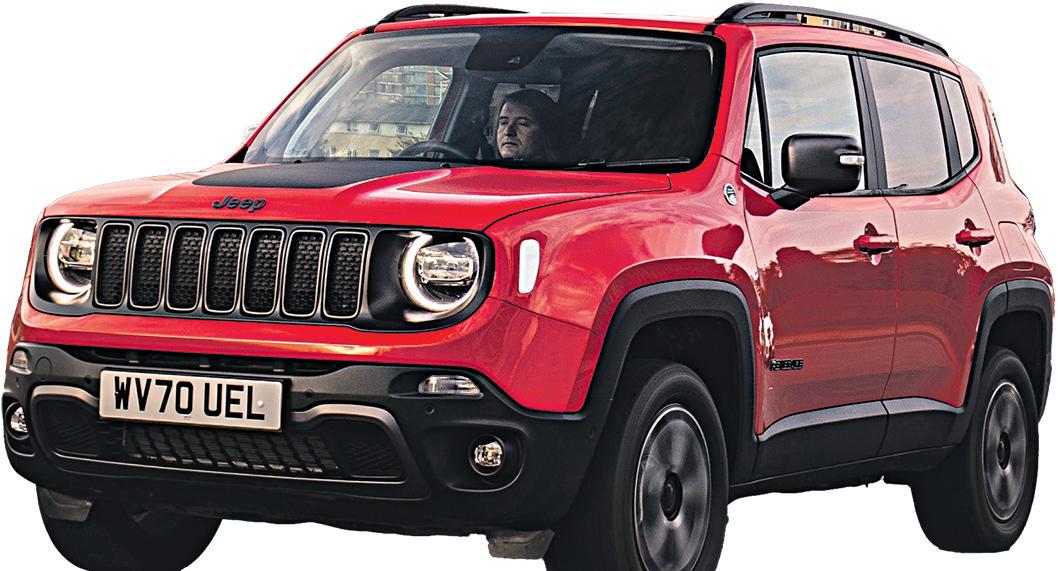
2 minute read
Jeep Renegade - one of the most likeable off-roaders
Road Test
byMarkSlack
EVERYONE knows that Land Rover has a fine, and well deserved, reputation for offroad ability. It seems that every other 4×4 takes second place to the Solihull masters of all terrain.
However, there’s another brand that has an equally fine reputation that precedes, indeed inspired, the genius of Maurice Wilks who founded Land Rover. Jeeps are synonymous with the Second World War and it was their ability to traverse seemingly any kind of landscape that led to some of the best offroad vehicles ever produced.
Jeep still produce chunky Tonkatoy like off roaders, and my test model was the Renegade 4xe in plug in hybrid form. The petrol part of the power equation is a 1.3litre 4cylinder turbocharged unit, the electrical assistance is provided by an 11.4 kwh battery.
The Renegade line up is priced from €34,173/£30,050 with the Renegade 4xe offered in Limited, or as with my test model, topspec Trailhawk trim. All the usual charging options are available including a standard domestic socket. Being a hybrid, smaller battery, on a domestic socket the charge time is as little as 4 hours. For that you have a commuting range of around 26 miles, maybe more depending upon your driving style, and modes for hybrid, electric and e save (which helps charge the battery along with maximum braking regeneration).

On the road the Renegade is probably one of the most practical hybrids I have driven, with a decent turn of speed, 62 mph in just 7.1 seconds, and a smooth 6speed automatic gearbox along with that allwheeldrive ability. That offers simple dial technology for the kind of surface you’re dealing with and even the ability to lock the system into low range for real mudplugging. In hybrid mode the transition between electric and petrol is smooth and as long as the battery isn’t extremely low esave mode and maximum regeneration means you can see the battery charge climb.
Standard fare is good with all the usual motoring accoutrements even on the leadin version with my €43,328/£38,100 Trailhawk model especially well appoint ed. The Jeep feels durable and is nicely appointed, but it battles against the fact that at this price it’s in Discovery Sport territory, albeit mild hybrid form rather than plugin.

The Discovery will be seen as a more premium choice and
I’m not sure the plugin versus mild hybrid systems will make much difference. It makes the Renegade’s job somewhat harder, which is a shame as the Jeep is one of the most capable, characterful and likeable off roaders you can buy.
Distance limit
PROPOSALS have been unveiled in a bid to limit hitting distance for elite golfers.
In what is certain to be a major story in the months and years to come, the R&A and USGA have re vealed their joint propos al for a Model Local Rule (MLR) that gives competition organisers the option to require use of golf balls which are tested under modified launch conditions to address the impacts of hitting distance in golf.
The MLR is intended for use only in elite competitions and, if adopted, will have no impact on recreational golf.
Golf balls that conform to the MLR must not exceed the current Overall Distance Standard (ODS) limit of 317 yards (plus three yards tolerance) at modified Actual Launch Conditions (ALC) with a clubhead speed of 127 mph and based on a calibration setup for 11 degrees and 37 revolutions per second (2220 rpm) as part of this proposal.

All other balls, including those typically used by recreational golfers with lower swing speeds, would continue to be tested using the existing ALC values (120 mph, and a calibration setup of 10 degrees and 42 revolutions per second 2520 rpm).










